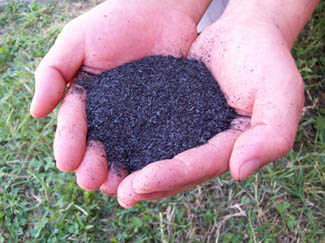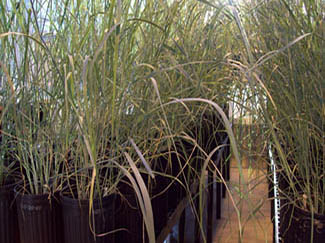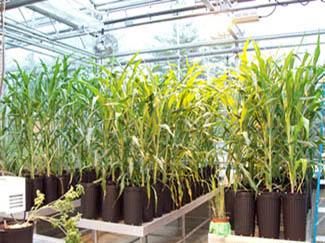An investigation of char-soil interactions and their impact on biomass yield
Concerns over increasing levels of atmospheric carbon dioxide (CO2) from the burning of fossil fuels and the potentially devastating effects of future global climate change have led to a search for strategies to remove CO2 from the atmosphere. Soil has been suggested as one of the most promising approaches for sequestering carbon (C) as it represents the largest terrestrial sink for CO2. Current storage of C as soil organic matter (SOM) in the top meter of soil is estimated at 1500-1600 Pg C, more than twice the amount in the atmosphere. The overall capacity of soils to sequester CO2 globally with changes in management is less well known and involves great uncertainty. In addition, questions remain as to the stability of sequestered C in soils.
The storage of C in SOM will depend on the rate of C cycling within the soil system. If respiration from roots and mineralization of SOM exceeds the incorporation of C in SOM then soils may potentially act as a source of atmospheric CO2 rather than a sink. In fact, soils are large contributors to atmospheric CO2, emitting ten times that contributed by fossil fuel combustion. The majority of plant residues and root exudates has a relatively short residence time in soil, months to a few years, and, therefore, do not represent a long-term sink for C sequestration. Because of this, plans for sequestering C in soils by way of reduced tillage, increased afforestation, and conversion of degraded lands may not provide the long-term solution for reducing atmospheric CO2. In fact, under scenarios of elevated atmospheric CO2, some studies have shown increased plant productivity via enhanced fine root growth, causing a subsequent increase in soil respiration.
The incorporation of biochar, however, presents a unique opportunity to better meet the goals of C soil sequestration. Biochar is formed from the thermal decomposition of biomass under conditions of limited oxygen and is a co-product of certain bioenergy conversion processes such as gasification and pyrolysis. Biochar is high in C and most, if not all, of that C is in recalcitrant forms. If the goal of C sequestration is to create a stable C pool in soil with maximum retention time, than biochar incorporation appears to be well-suited. It has been estimated to have a residence time in soil in the range of thousands of years or more. When biochar incorporation is practiced in conjunction with bioenergy crop production, it represents an extreme advantage over current energy production systems in terms of C-cycling efficiency, providing a C-negative energy source while sequestering large amounts of C in soil. In addition to providing a long-term solution to removing atmospheric CO2, biochar provides soil quality benefits that include increased plant yield, retention of nutrients, decreased soil acidity, and improved soil physical properties.
However, numerous questions related to biochar application to soil still remain. How does biochar with different characteristics (i.e. different feedstocks, different thermal conditions) behave in different soil types with different management practices? What are the interactions between biochar and nutrient cycling and microbial activity and how do these affect agronomic productivity? How do different biochars weather, or degrade, in the soil over time? We examined these questions in the context of a larger bioenergy production system involving the pyrolytic conversion of bio-feedstocks to energy in which biochar is returned to the soil in order to: i) sequester C, and ii) secure the production base for bioenergy crops.
Principal Investigators: Drs. Timothy Rials, Nicole Labbé, Amy M. Johnson, Mark Radosevich




